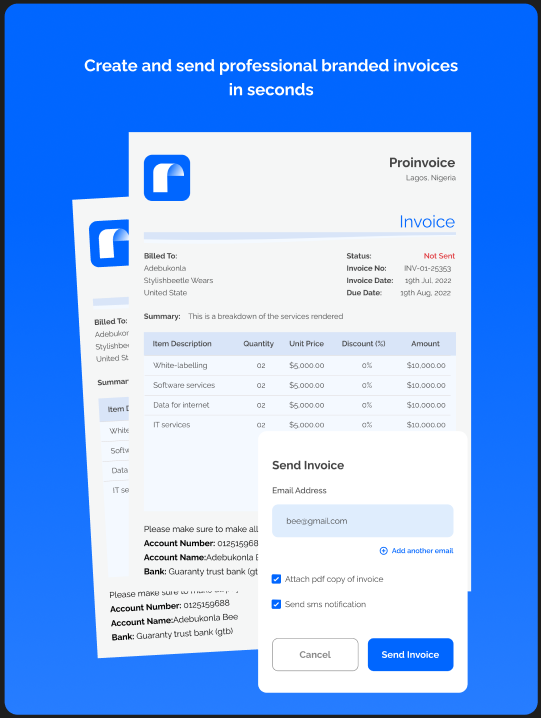After setting up a business, the next step is to source for clients, getting your first client means you’ll need to create your first invoice with hope of getting paid as a business owner.
As far as invoicing is concerned, there are procedures you need to follow so that you do not present yourself as a rookie to your client when you send your first invoice.
If you want to know how to get started, here is all you need to know about creating your first invoice.
Step-By-Step Procedures on How to Create Your First Invoice
1. Select a Business Invoice System
Some years ago, creating an invoice system cost a lot of money. But times have changed and it is now as easy as it can be.
If you want to create an invoice system now, you can do that by searching on the internet. Some platforms charge little amounts while some platforms will help you create an invoice system for free.
One of the platforms where you can create a free invoice system is ProInvoice.
2. Create a Header
The header is the first point of contact between your invoice and your client. If your header is not top-notch, your client might feel disappointed.
For people who have taught before, you will feel disappointed if your student is not able to answer the first question perfectly.
You might lose interest in marking other questions even if the students did very well in answering the other questions. If you have a logo, put it at the top-right corner of the header.
Then, your business name should be written boldly in a bigger font. After that, you should include your business address, phone number, email address, and website if available in a font not as big as the business name.
3. Add Client’s Details
Adding your client’s information is as important as your information because it can help you track payments and other outstanding invoices.
Include your client’s name, phone number, email address, address, and other information that will make it easy for you to contact him anytime you need his attention.
Your Client’s details should be placed beneath or beside your contact information.
4. Include Invoice Number
The importance of numbering an invoice is that it helps you keep track of your invoices. If an invoice is numbered, it is easy to track.
5. Add Date
The importance of including a date in your invoice is almost the same as the point we made above.
If you do not include the date in an invoice, you might not be able to track which payments were made, when the payments were made, and how the payments were made.
6. Terms of Payment
In order not to get cheated or taken for granted by some clients, you should include the terms of payment in your invoice.
Make sure it is written in simple English that everyone can understand to avoid an argument. Here are three things you should consider in your terms of payment
a. Method Payment: List all the acceptable methods of payment under this. Also, if there is a popular payment method is not acceptable to you, let your client know.
For example, Payooner is a popular mode of payment, but not all businesses accept it. If your business does not accept it too, let your client know through your invoice.
b. Down Payments: Some people require a down payment before they can start any job while some businesses preferred to be paid after the job has been completed.
Whichever method you prefer, it should be spelled out clearly in your invoice.
c. Days Before Payment is Due: To avoid late payment, your client should know when you are expecting your payment.
Also, you should include the penalty that will be incurred if your payment is not done as of the agreed date.
7. Remittance
Remittance advice is only applicable if you are not going to receive payments in any other form apart from electronic payment.
If you will accept payment by check, you should add a perforated, tear-off section on your statement.
When a client wants to make a payment, he or she can tear off the portion of the statement and send it along with their payment.
As soon as you receive the payment, it will be easy to know the account and the statement it applies to.
8. Services
All the services rendered to the client should be included in the invoice. It gives clarity to the invoice. It saves you the stress of explaining how you arrived at the total fee.
9. Keep a Copy
Lastly, do not forget to keep a backup copy of the invoice you send. It will help you track payments and it will also help when it is time to do your taxes.
Anything can happen, so keeping a copy of your invoice will prevent chaos. Use these quick tips when creating your first invoice:
- Use the ProInvoice feature for fast invoicing that looks accurate and professional.
- Set up payment schedule reminders to be issued automatically to remind clients of invoices that are due.
- Make it a habit of always checking your invoice at the beginning and the end of each day’s activities.
Conclusion
Anything you put out relating to your business, you owe yourself a duty to make it professional.
In this internet age, you have no excuse to do unprofessional jobs with the amount of information littered on the internet.
Invoicing is a key part of any business. If you have done the hardest part which is sourcing for clients, why should you let yourself down when it is time to get the reward for your hard work?
We have been able to provide enough information that will make your first invoice a smooth operation.













